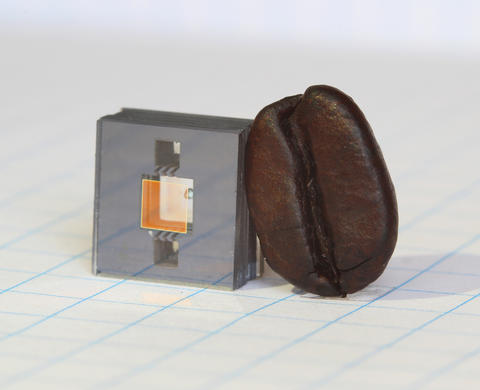Chip-Scale Clocks
The Technology

In 2004, NIST scientists created the first chip-scale atomic clock. The core components were about the size of a grain of rice. The device operated at gigahertz frequencies, and the technology was promptly commercialized.
Since then, NIST researchers have focused on improvements to its design. The latest potentially manufacturable version is about a hundred times more stable and accurate than the original. Its vapor cell is smaller than a pencil eraser. It operates at optical frequencies of several hundred terahertz, so it is capable of more precise timekeeping. If commercialized, it could be deployed to provide highly stable and accurate timekeeping with low power consumption and low cost.
The latest chip-scale clock design is based on rubidium atoms confined in a tiny glass container on a chip. Two frequency combs on chips act like gears to link the device’s high-frequency optical signals to a lower, widely used microwave frequency that can be used in applications. The chip-based heart of the new clock requires very little power (just 275 milliwatts) and, with additional technology advances, could potentially be made small enough to be handheld.
Ultimately, the next-generation chip-scale atomic clock will be engineered to fit onto NIST’s miniaturized instrument platforms now in development. The platforms will have to support and integrate atomic-clock features with dimensions on the scale of micrometers.
Advantages Over Existing Methods
The new chip-scale designs open up a world of new applications simply through their portability. Most atomic clocks, from highly precise optical lattice clocks to novel quantum logic clocks, are big laboratory devices. The same is true for the national standard NIST atomic “fountain” clocks that determine U.S. official time. Though they offer the highest levels of accuracy in timekeeping, they are large, expensive and unsuited to use in the field or factory.
Applications
NIST’s compact two-photon vapor-cell clock can be used as an improved portable timing standard for various kinds of technologies, including as a backup to the satellite-based GPS.
Widespread use of next-generation chip-scale atomic clocks could provide an even more accurate benchmark for calibrating GPS timing signals, which are indispensable to a host of systems that must be precisely synchronized, such as cellphone communications, the nation’s electric power grid, airline navigation and numerous defense applications.
Additional current and anticipated practical applications include readily deployable, quantum-accurate timing standards for industry and defense, underwater seismic sensing for oil and mineral exploration, and secure wireless communications.
The more that NIST scientists can reduce the size and increase the accuracy of an atomic clock, the more uses it will have, the more places it can go, and the less power it will need. Efficient operation is particularly important for mobile operations that run on battery power.
Key Papers
Yang Li, Donggyu B. Sohn, Matthew T. Hummon, Susan Schima and John Kitching. Wafer-scale fabrication of evacuated alkali vapor cells. Optics Letters. Published Aug. 28, 2024. DOI: 10.1364/OL.527351
Vincent Maurice, Zachary L. Newman, Susannah Dickerson, Morgan Rivers, James Hsiao, Phillip Greene, Mark Mescher, John Kitching, Matthew T. Hummon and Cort Johnson. Miniaturized optical frequency reference for next-generation portable optical clocks. Optics Express. Published Aug. 7, 2020. DOI: 10.1364/OE.396296
Z.L. Newman, V. Maurice, T. Drake, J.R. Stone, T.C. Briles, D.T. Spencer, C. Fredrick, Q. Li, D. Westly, B.R. Ilic, B. Shen, M.-G. Suh, K.Y. Yang, C. Johnson, D.M.S. Johnson, L. Hollberg, K.J. Vahala, K. Srinivasan, S.A. Diddams, J. Kitching, S.B. Papp and M.T. Hummon. Architecture for the photonic integration of an optical atomic clock. Optica. Published May 20, 2019. DOI: 10.1364/OPTICA.6.000680
Key Patents
J. Kitching. Process for making alkali metal vapor cells. United States Patent 11,180,844.
Contacts
-
(303) 497-4083

